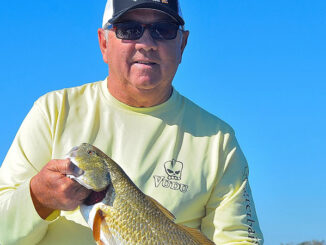
Green means go, and that’s what one Lydia charter captain looks for to fill an ice chest with redfish in July.
“I fish against the grass beds. I look for green grass beds in Cote Blanche Bay, the west side,” Drew Romero said.
Those waters have been his stomping grounds, so to speak, since he started fishing with his father, Brian Romero, who started Smokin’ Reels Charters LLC in the early 2000s. Drew Romero, a crawfisherman who also works as a mechanic at Morton Salt, started guiding around 2010.

“Oh, yeah, that’s what I grew up doing. I never went to Marsh Island. I fished Cote Blanche all my life. Me and my dad fish a lot over there,” Romero said.
After the Atchafalaya River finally falls in late spring or early summer, water clarity and salinity start to improve in West Cote Blanche Bay and East Cote Blanche Bay. Romero targets the western side of the bay system from The Hammock, which is near Cypremort Point, all the way to The Jaws between Hog Bayou and Bayou Bartholomew.
Romero catches plenty of redfish there and, he said, “some trout sometimes if the water’s salty and green.” The redfish usually measure 16 inches long but sometimes are as heavy as 25 pounds.
Romero’s tactics
Most of the time, he’s hooking up with and boating redfish in 1½- to 2-foot depths. He’ll fish likely looking grass beds for 10 or 15 minutes, as well as any rock piles along the way, and he’ll move on if he doesn’t get any takers.
“If you catch one, you’ll catch four or five in a spot, you know?” he said. “Sometimes, I’ll start off the morning with a popping cork and shrimp on a leadhead. Then, a couple hours later, I’ll switch to a ½-ounce gold spoon and a spinnerbait with a lemonhead or pink Matrix Shad — if the water’s clear enough.
“Later, if the fish don’t bite, I’ll bounce shrimp on a leadhead on the bottom. Fish with one of those three, and you ought to start catching fish. They’re going to eat something,” Romero said.
If the water’s high, he’ll fish in and over the grass with the shrimp under a popping cork. If it’s low, he’ll fish along the edge.
“It’s just plain and simple,” he said.
A sandy-clay bottom mixed with a shell bottom is a haven for crustaceans and baitfish — delicacies for redfish and other species — that move in and out of the marshes around the bay as the tide rises and falls.
Other fish
As for speckled trout, the stars need to align.
“You have to have perfect conditions, saltwater and no wind. You’re going to catch them around rock piles, not grass. Some are off the bank and some are on the bank,” he said.
Anglers fishing the area also pick up sheepshead, flounder and croakers, he said.
Last July, he said, “Was pretty decent. Sometimes, you have to wait a little longer to fish over there.”
As he knows from experience, it’s well worth the wait.


